Hive存储格式选择 和Hive 相关优化:
压缩参考
Hive支持的存储数的格式主要有:TEXTFILE 、SEQUENCEFILE、ORC、PARQUET。
文件存储格式
列式存储和行式存储
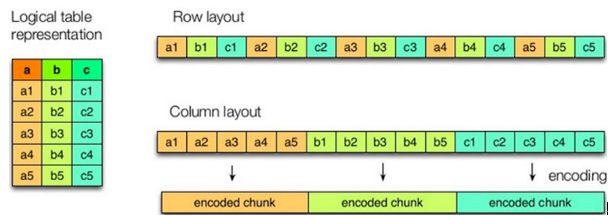
行存储的特点:查询满足条件的一整行数据的时候,列存储则需要去每个聚集的字段找到对应的每个列的值,行存储只需要找到其中一个值,其余的值都在相邻地方,所以此时行存储查询的速度更快。
列存储的特点:因为每个字段的数据聚集存储,在查询只需要少数几个字段的时候,能大大减少读取的数据量;每个字段的数据类型一定是相同的,列式存储可以针对性的设计更好的设计压缩算法。
TEXTFILE和SEQUENCEFILE的存储格式都是基于行存储的;ORC和PARQUET是基于列式存储的。
TextFile格式
默认格式,数据不做压缩,磁盘开销大,数据解析开销大。可结合Gzip、Bzip2使用,但使用Gzip这种方式,hive不会对数据进行切分,从而无法对数据进行并行操作。
Orc格式
Orc (Optimized Row Columnar)是Hive 0.11版里引入的新的存储格式。
每个Orc文件由1个或多个stripe组成,每个stripe250MB大小,这个Stripe实际相当于RowGroup概念,不过大小由4MB->250MB,这样应该能提升顺序读的吞吐率。每个Stripe里有三部分组成,分别是Index Data,Row Data,Stripe Footer:
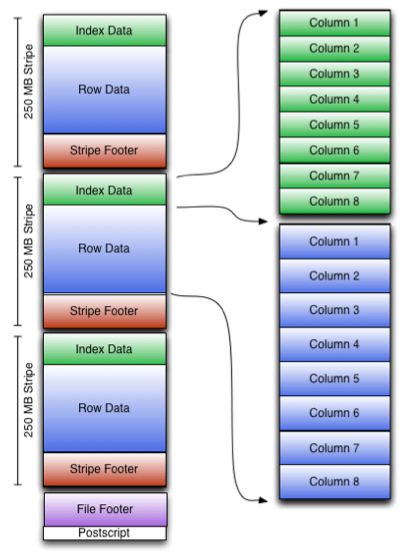
Index Data:一个轻量级的index,默认是每隔1W行做一个索引。这里做的索引应该只是记录某行的各字段在Row Data中的offset。
Row Data:存的是具体的数据,先取部分行,然后对这些行按列进行存储。对每个列进行了编码,分成多个Stream来存储。
Stripe Footer:存的是各个Stream的类型,长度等信息。
每个文件有一个File Footer,这里面存的是每个Stripe的行数,每个Column的数据类型信息等;每个文件的尾部是一个PostScript,这里面记录了整个文件的压缩类型以及FileFooter的长度信息等。在读取文件时,会seek到文件尾部读PostScript,从里面解析到File Footer长度,再读FileFooter,从里面解析到各个Stripe信息,再读各个Stripe,即从后往前读。
Parquet格式
Parquet是面向分析型业务的列式存储格式,由Twitter和Cloudera合作开发,2015年5月从Apache的孵化器里毕业成为Apache顶级项目。
Parquet文件是以二进制方式存储的,所以是不可以直接读取的,文件中包括该文件的数据和元数据,因此Parquet格式文件是自解析的。
通常情况下,在存储Parquet数据的时候会按照Block大小设置行组的大小,由于一般情况下每一个Mapper任务处理数据的最小单位是一个Block,这样可以把每一个行组由一个Mapper任务处理,增大任务执行并行度。
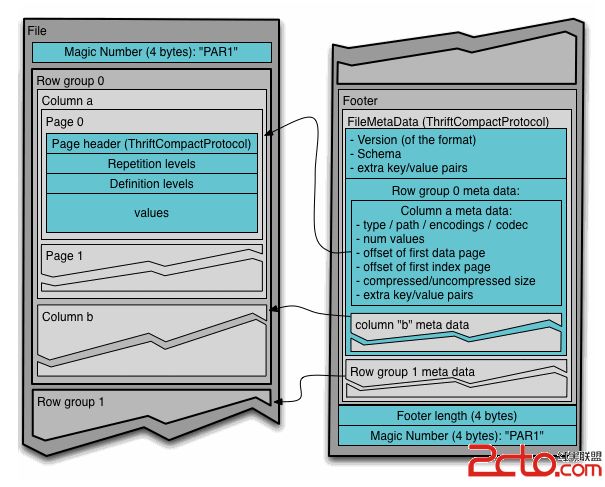
Parquet文件的内容,一个文件中可以存储多个行组,文件的首位都是该文件的Magic Code,用于校验它是否是一个Parquet文件,Footer length记录了文件元数据的大小,通过该值和文件长度可以计算出元数据的偏移量,文件的元数据中包括每一个行组的元数据信息和该文件存储数据的Schema信息。除了文件中每一个行组的元数据,每一页的开始都会存储该页的元数据,在Parquet中,有三种类型的页:数据页、字典页和索引页。数据页用于存储当前行组中该列的值,字典页存储该列值的编码字典,每一个列块中最多包含一个字典页,索引页用来存储当前行组下该列的索引,目前Parquet中还不支持索引页。
在实际的项目开发当中,hive表的数据存储格式一般选择:orc或parquet。压缩方式一般选择snappy,lzo。
调优
Fetch抓取
Fetch抓取是指,Hive中对某些情况的查询可以不必使用MapReduce计算。例如:SELECT * FROM employees;在这种情况下,Hive可以简单地读取employee对应的存储目录下的文件,然后输出查询结果到控制台。
在hive-default.xml.template文件中hive.fetch.task.conversion默认是more,老版本hive默认是minimal,该属性修改为more以后,在全局查找、字段查找、limit查找等都不走mapreduce。
hive.fetch.task.conversion设置成more,然后执行查询语句,如下查询方式都不会执行mapreduce程序。
本地模式
大多数的Hadoop Job是需要Hadoop提供的完整的可扩展性来处理大数据集的。不过,有时Hive的输入数据量是非常小的。在这种情况下,为查询触发执行任务消耗的时间可能会比实际job的执行时间要多的多。对于大多数这种情况,Hive可以通过本地模式在单台机器上处理所有的任务。对于小数据集,执行时间可以明显被缩短。
用户可以通过设置hive.exec.mode.local.auto的值为true,来让Hive在适当的时候自动启动这个优化。
1
2
3
4
5
6
|
#
set hive.exec.mode.local.auto=true;
#
set hive.exec.mode.local.auto.inputbytes.max=50000000;
#
set hive.exec.mode.local.auto.input.files.max=10;
|
1
2
3
4
5
6
7
8
9
|
set hive.exec.mode.local.auto=true;
select * from emp cluster by deptno;
Time taken: 1.768 seconds, Fetched: 14 row(s)
set hive.exec.mode.local.auto=false;
select * from emp cluster by deptno;
Time taken: 41.728 seconds, Fetched: 14 row(s)
|
表的调优
小表、大表Join
将key相对分散,并且数据量小的表放在join的左边,这样可以有效减少内存溢出错误发生的几率;再进一步,可以使用map join让小的维度表(1000条以下的记录条数)先进内存。在map端完成reduce。
实际测试发现:新版的hive已经对小表JOIN大表和大表JOIN小表进行了优化。小表放在左边和右边已经没有明显区别。
1
2
3
4
5
6
7
8
9
10
11
12
13
14
15
16
17
18
19
20
21
22
23
24
25
26
27
28
29
30
31
32
33
34
|
create table bigtable(id bigint, time bigint, uid string, keyword string, url_rank int, click_num int, click_url string) row format delimited fields terminated by '\t';
create table smalltable(id bigint, time bigint, uid string, keyword string, url_rank int, click_num int, click_url string) row format delimited fields terminated by '\t';
create table jointable(id bigint, time bigint, uid string, keyword string, url_rank int, click_num int, click_url string) row format delimited fields terminated by '\t';
load data local inpath '/opt/module/datas/bigtable' into table bigtable;
load data local inpath '/opt/module/datas/smalltable' into table smalltable;
set hive.auto.convert.join = false;
insert overwrite table jointable
select b.id, b.time, b.uid, b.keyword, b.url_rank, b.click_num, b.click_url
from smalltable s
left join bigtable b
on b.id = s.id;
MapReduce Total cumulative CPU time: 37 seconds 840 msec
Time taken: 79.018 seconds
insert overwrite table jointable
select b.id, b.time, b.uid, b.keyword, b.url_rank, b.click_num, b.click_url
from bigtable b
left join smalltable s
on s.id = b.id;
MapReduce Total cumulative CPU time: 38 seconds 700 msec
Time taken: 77.68 seconds
|
大表Join大表
空KEY过滤
有时join超时是因为某些key对应的数据太多,而相同key对应的数据都会发送到相同的reducer上,从而导致内存不够。此时我们应该仔细分析这些异常的key,很多情况下,这些key对应的数据是异常数据,我们需要在SQL语句中进行过滤。例如key对应的字段为空,操作如下:
1
2
|
#
[hadoop@datanode1 ~]$ sbin/mr-jobhistory-daemon.sh start historyserver
|
1
2
3
4
5
6
7
8
9
10
11
12
13
14
15
16
17
18
19
20
21
22
23
24
|
create table ori(id bigint, time bigint, uid string, keyword string, url_rank int, click_num int, click_url string) row format delimited fields terminated by '\t';
create table nullidtable(id bigint, time bigint, uid string, keyword string, url_rank int, click_num int, click_url string) row format delimited fields terminated by '\t';
create table jointable(id bigint, time bigint, uid string, keyword string, url_rank int, click_num int, click_url string) row format delimited fields terminated by '\t';
load data local inpath '/opt/module/datas/ori' into table ori;
load data local inpath '/opt/module/datas/nullid' into table nullidtable;
insert overwrite table jointable select n.* from nullidtable n left join ori o on n.id = o.id;
Stage-Stage-1: Map: 2 Reduce: 1 Cumulative CPU: 40.44 sec HDFS Read: 248162775 HDFS Write: 122733608 SUCCESS
Time taken: 91.165 seconds
Stage-Stage-1: Map: 2 Reduce: 1 Cumulative CPU: 32.52 sec HDFS Read: 248165536 HDFS Write: 25445558 SUCCESS
Time taken: 76.158 seconds
|
空key转换
有时虽然某个key为空对应的数据很多,但是相应的数据不是异常数据,必须要包含在join的结果中,此时我们可以表a中key为空的字段赋一个随机的值,使得数据随机均匀地分不到不同的reducer上。
不设置空值
1
2
|
insert overwrite table jointable
select n.* from nullidtable n left join ori b on n.id = b.id;
|
这里发生了数据偏斜:某些reducer的资源消耗远大于其他reduce。
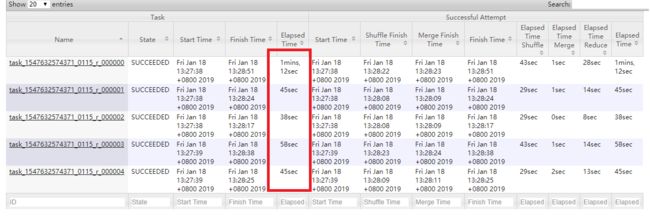
随机分布空null值
1
2
3
4
5
6
7
|
set mapreduce.job.reduces = 5;
insert overwrite table jointable
select n.* from nullidtable n full join ori o on
case when n.id is null then concat('hive', rand()) else n.id end = o.id;
|

我们可以看出总体平均消耗的资源差不多,因此,消除了数据倾斜,负载均衡reducer的资源消耗。
MapJoin
如果不指定MapJoin或者不符合MapJoin的条件,那么Hive解析器会将Join操作转换成Common Join,即:在Reduce阶段完成join。容易发生数据倾斜。可以用MapJoin把小表全部加载到内存在map端进行join,避免reducer处理。
1
2
3
4
5
6
|
set hive.auto.convert.join = true;
大表小表的阈值设置(默认25M一下认为是小表)
set hive.mapjoin.smalltable.filesize=25000000;
|
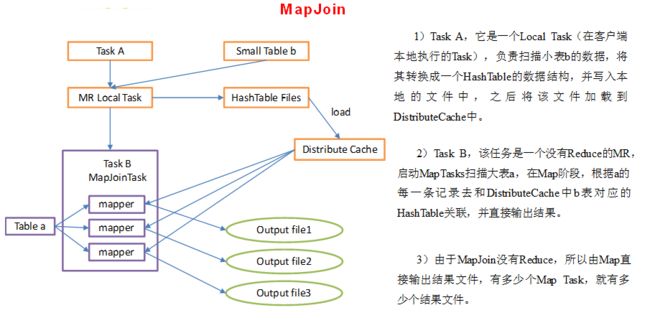
1
2
3
4
5
6
7
8
9
10
11
12
13
14
15
16
|
insert overwrite table jointable
select b.id, b.time, b.uid, b.keyword, b.url_rank, b.click_num, b.click_url
from smalltable s
join bigtable b
on s.id = b.id;
Time taken: 49.829 seconds
insert overwrite table jointable
select b.id, b.time, b.uid, b.keyword, b.url_rank, b.click_num, b.click_url
from bigtable b
join smalltable s
on s.id = b.id;
Time taken: 48.565 seconds
|
Group By
默认情况下,Map阶段同一Key数据分发给一个reduce,当一个key数据过大时就倾斜了。
并不是所有的聚合操作都需要在Reduce端完成,很多聚合操作都可以先在Map端进行部分聚合,最后在Reduce端得出最终结果。
1
2
3
4
5
6
7
8
|
hive.map.aggr = true
hive.groupby.mapaggr.checkinterval = 100000
hive.groupby.skewindata = true
|
当选项设定为 true,生成的查询计划会有两个MR Job。第一个MR Job中,Map的输出结果会随机分布到Reduce中,每个Reduce做部分聚合操作,并输出结果,这样处理的结果是相同的Group By Key有可能被分发到不同的Reduce中,从而达到负载均衡的目的;第二个MR Job再根据预处理的数据结果按照Group By Key分布到Reduce中(这个过程可以保证相同的Group By Key被分布到同一个Reduce中),最后完成最终的聚合操作。
Count(Distinct) 去重统计
数据量小的时候无所谓,数据量大的情况下,由于COUNT DISTINCT操作需要用一个Reduce Task来完成,这一个Reduce需要处理的数据量太大,就会导致整个Job很难完成,一般COUNT DISTINCT使用先GROUP BY再COUNT的方式替换:
1
2
3
4
5
6
7
8
9
10
11
12
13
14
15
16
17
18
19
20
21
22
23
24
25
26
27
28
|
create table bigtable(id bigint, time bigint, uid string, keyword
string, url_rank int, click_num int, click_url string) row format delimited
fields terminated by '\t';
load data local inpath '/opt/module/datas/bigtable' into table bigtable;
set mapreduce.job.reduces = 5;
select count(distinct id) from bigtable;
MapReduce Jobs Launched:
Stage-Stage-1: Map: 1 Reduce: 1 Cumulative CPU: 13.53 sec HDFS Read: 129164386 HDFS Write: 6 SUCCESS
Total MapReduce CPU Time Spent: 13 seconds 530 msec
OK
99947
Time taken: 50.453 seconds, Fetched: 1 row(s)
Stage-Stage-1: Map: 1 Reduce: 5 Cumulative CPU: 27.89 sec HDFS Read: 129175319 HDFS Write: 580 SUCCESS
Stage-Stage-2: Map: 2 Reduce: 1 Cumulative CPU: 7.83 sec HDFS Read: 7729 HDFS Write: 6 SUCCESS
Total MapReduce CPU Time Spent: 35 seconds 720 msec
OK
99947
Time taken: 110.944 seconds, Fetched: 1 row(s)
|
虽然会多用一个Job来完成,但在数据量大的情况下,这个绝对是值得。
笛卡尔积
尽量避免笛卡尔积,join的时候不加on条件,或者无效的on条件,Hive只能使用1个reducer来完成笛卡尔积。
行列过滤
列处理:在SELECT中,只拿需要的列,如果有,尽量使用分区过滤,少用SELECT *。
行处理:在分区剪裁中,当使用外关联时,如果将副表的过滤条件写在Where后面,那么就会先全表关联,之后再过滤,比如:
1
2
3
4
5
6
7
8
9
10
11
|
select o.id from bigtable b
join ori o on o.id = b.id
where o.id <= 10;
Time taken: 68.819 seconds, Fetched: 100 row(s)
select b.id from bigtable b
join (select id from ori where id <= 10 ) o on b.id = o.id;
Time taken: 66.287 seconds, Fetched: 100 row(s)
|
动态分区调整
关系型数据库中,对分区表Insert数据时候,数据库自动会根据分区字段的值,将数据插入到相应的分区中,Hive中也提供了类似的机制,即动态分区(Dynamic Partition),只不过,使用Hive的动态分区,需要进行相应的配置。
1
2
3
4
5
6
7
8
9
10
11
12
13
14
15
16
17
18
19
20
21
22
23
24
25
26
27
28
29
30
31
32
33
34
35
36
37
38
39
40
41
42
43
44
45
46
47
48
49
|
hive.exec.dynamic.partition=true
hive.exec.dynamic.partition.mode=nonstrict
hive.exec.max.dynamic.partitions=1000
hive.exec.max.dynamic.partitions.pernode=100
hive.exec.max.created.files=100000
hive.error.on.empty.partition=false
create table ori_partitioned(id bigint, time bigint, uid string, keyword string,
url_rank int, click_num int, click_url string)
partitioned by (p_time bigint)
row format delimited fields terminated by '\t';
load data local inpath '/opt/module/datas/ds1' into table
ori_partitioned partition(p_time='201901180000010');
load data local inpath '/opt/module/datas/ds2' into table ori_partitioned partition(p_time='201901180000011');
create table ori_partitioned_target(id bigint, time bigint, uid string,
keyword string, url_rank int, click_num int, click_url string) PARTITIONED BY (p_time STRING) row format delimited fields terminated by '\t';
set hive.exec.dynamic.partition = true;
set hive.exec.dynamic.partition.mode = nonstrict;
set hive.exec.max.dynamic.partitions = 1000;
set hive.exec.max.dynamic.partitions.pernode = 100;
set hive.exec.max.created.files = 100000;
set hive.error.on.empty.partition = false;
insert overwrite table ori_partitioned_target partition (p_time)
select id, time, uid, keyword, url_rank, click_num, click_url, p_time from ori_partitioned;
show partitions ori_partitioned_target;
OK
p_time=201901180000010
p_time=201901180000011
|
分桶
桶表相关
分区
分区表相关
数据倾斜
合理设置Map数
1.通常情况下,作业会通过input的目录产生一个或者多个map任务。主要的决定因素有:input的文件总个数,input的文件大小,集群设置的文件块大小。
2.是不是map数越多越好?
答案是否定的。如果一个任务有很多小文件(远远小于块大小128m),则每个小文件也会被当做一个块,用一个map任务来完成,而一个map任务启动和初始化的时间远远大于逻辑处理的时间,就会造成很大的资源浪费。而且,同时可执行的map数是受限的。
3)是不是保证每个map处理接近128m的文件块,就高枕无忧了?
答案也是不一定。比如有一个127m的文件,正常会用一个map去完成,但这个文件只有一个或者两个小字段,却有几千万的记录,如果map处理的逻辑比较复杂,用一个map任务去做,肯定也比较耗时。
针对上面的问题2和3,我们需要采取两种方式来解决:即减少map数和增加map数;
小文件进行合并
在map执行前合并小文件,减少map数:CombineHiveInputFormat具有对小文件进行合并的功能(系统默认的格式)。HiveInputFormat没有对小文件合并功能。
1
|
set hive.input.format= org.apache.hadoop.hive.ql.io.CombineHiveInputFormat;
|
复杂文件增加Map数
当input的文件都很大,任务逻辑复杂,map执行非常慢的时候,可以考虑增加Map数,来使得每个map处理的数据量减少,从而提高任务的执行效率。
增加map的方法为:根据computeSliteSize(Math.max(minSize,Math.min(maxSize,blocksize)))=blocksize=128M公式,调整maxSize最大值。让maxSize最大值低于blocksize就可以增加map的个数。
1
2
3
4
5
6
7
|
select count(*) from emp;
Stage-Stage-1: Map: 1 Reduce: 1 Cumulative CPU: 5.98 sec HDFS Read: 7861 HDFS Write: 3 SUCCESS
set mapreduce.input.fileinputformat.split.maxsize=100;
Hadoop job information for Stage-1: number of mappers: 6; number of reducers: 1
|
合理设置Reduce数
调整reduce个数方法一
1
2
3
4
5
6
7
8
|
hive.exec.reducers.bytes.per.reducer=256000000
hive.exec.reducers.max=1009
N=min(参数2,总输入数据量/参数1)
|
调整reduce个数方法二
1
2
3
|
set mapreduce.job.reduces = 15;
|
reduce个数并不是越多越好?
1.过多的启动和初始化reduce也会消耗时间和资源;
2.另外,有多少个reduce,就会有多少个输出文件,如果生成了很多个小文件,那么如果这些小文件作为下一个任务的输入,则也会出现小文件过多的问题;
在设置reduce个数的时候也需要考虑这两个原则:处理大数据量利用合适的reduce数;使单个reduce任务处理数据量大小要合适;
并行执行
Hive会将一个查询转化成一个或者多个阶段。这样的阶段可以是MapReduce阶段、抽样阶段、合并阶段、limit阶段。或者Hive执行过程中可能需要的其他阶段。默认情况下,Hive一次只会执行一个阶段。不过,某个特定的job可能包含众多的阶段,而这些阶段可能并非完全互相依赖的,也就是说有些阶段是可以并行执行的,这样可能使得整个job的执行时间缩短。不过,如果有更多的阶段可以并行执行,那么job可能就越快完成。
通过设置参数hive.exec.parallel值为true,就可以开启并发执行。不过,在共享集群中,需要注意下,如果job中并行阶段增多,那么集群利用率就会增加。
1
2
|
set hive.exec.parallel=true;
set hive.exec.parallel.thread.number=16;
|
当然,得是在系统资源比较空闲的时候才有优势,否则,没资源,并行也起不来。
严格模式
Hive提供了一个严格模式,可以防止用户执行那些可能意向不到的不好的影响的查询。通过设置属性hive.mapred.mode值为默认是非严格模式nonstrict 。开启严格模式需要修改hive.mapred.mode值为strict,开启严格模式可以禁止3种类型的查询。
1
2
3
4
5
6
7
8
9
10
11
12
13
|
<property>
<name>hive.mapred.modename>
<value>strictvalue>
<description>
The mode in which the Hive operations are being performed.
In strict mode, some risky queries are not allowed to run. They include:
Cartesian Product.
No partition being picked up for a query.
Comparing bigints and strings.
Comparing bigints and doubles.
Orderby without limit.
description>
property>
|
对于分区表,除非where语句中含有分区字段过滤条件来限制范围,否则不允许执行。换句话说,就是用户不允许扫描所有分区。进行这个限制的原因是,通常分区表都拥有非常大的数据集,而且数据增加迅速。没有进行分区限制的查询可能会消耗令人不可接受的巨大资源来处理这个表。
对于使用了order by语句的查询,要求必须使用limit语句。因为order by为了执行排序过程会将所有的结果数据分发到同一个Reducer中进行处理,强制要求用户增加这个LIMIT语句可以防止Reducer额外执行很长一段时间。
限制笛卡尔积的查询。对关系型数据库非常了解的用户可能期望在执行JOIN查询的时候不使用ON语句而是使用where语句,这样关系数据库的执行优化器就可以高效地将WHERE语句转化成那个ON语句。不幸的是,Hive并不会执行这种优化,因此,如果表足够大,那么这个查询就会出现不可控的情况。
JVM重用
JVM重用是Hadoop调优参数的内容,其对Hive的性能具有非常大的影响,特别是对于很难避免小文件的场景或task特别多的场景,这类场景大多数执行时间都很短。
Hadoop的默认配置通常是使用派生JVM来执行map和Reduce任务的。这时JVM的启动过程可能会造成相当大的开销,尤其是执行的job包含有成百上千task任务的情况。JVM重用可以使得JVM实例在同一个job中重新使用N次。N的值可以在Hadoop的mapred-site.xml文件中进行配置。通常在10-20之间,具体多少需要根据具体业务场景测试得出。
1
2
3
4
5
6
|
<property>
<name>mapreduce.job.jvm.numtasksname>
<value>10value>
<description>How many tasks to run per jvm. If set to -1, there is dsno limit.
description>
property>
|
缺点:开启JVM重用将一直占用使用到的task插槽,以便进行重用,直到任务完成后才能释放。如果某个“不平衡的”job中有某几个reduce task执行的时间要比其他Reduce task消耗的时间多的多的话,那么保留的插槽就会一直空闲着却无法被其他的job使用,直到所有的task都结束了才会释放。
推测执行
在分布式集群环境下,因为程序Bug(包括Hadoop本身的bug),负载不均衡或者资源分布不均等原因,会造成同一个作业的多个任务之间运行速度不一致,有些任务的运行速度可能明显慢于其他任务(比如一个作业的某个任务进度只有50%,而其他所有任务已经运行完毕),则这些任务会拖慢作业的整体执行进度。为了避免这种情况发生,Hadoop采用了推测执行(Speculative Execution)机制,它根据一定的法则推测出“拖后腿”的任务,并为这样的任务启动一个备份任务,让该任务与原始任务同时处理同一份数据,并最终选用最先成功运行完成任务的计算结果作为最终结果。
1
2
3
4
5
6
7
8
9
10
11
12
13
14
15
16
17
18
19
20
21
|
<property>
<name>mapreduce.map.speculativename>
<value>truevalue>
<description>If true, then multiple instances of some map tasks
may be executed in parallel.description>
property>
<property>
<name>mapreduce.reduce.speculativename>
<value>truevalue>
<description>If true, then multiple instances of some reduce tasks
may be executed in parallel.description>
property>
hive本身也提供了配置项来控制reduce-side的推测执行:
<property>
<name>hive.mapred.reduce.tasks.speculative.executionname>
<value>truevalue>
<description>Whether speculative execution for reducers should be turned on. description>
property>
|
关于调优这些推测执行变量,还很难给一个具体的建议。如果用户对于运行时的偏差非常敏感的话,那么可以将这些功能关闭掉。如果用户因为输入数据量很大而需要执行长时间的map或者Reduce task的话,那么启动推测执行造成的浪费是非常巨大大。
压缩
压缩相关资料
执行计划(Explain)
1
2
3
4
5
6
7
8
9
10
|
EXPLAIN [EXTENDED | DEPENDENCY | AUTHORIZATION] query
explain select * from emp;
explain select deptno, avg(sal) avg_sal from emp group by deptno;
explain extended select * from emp;
explain extended select deptno, avg(sal) avg_sal from emp group by deptno;
|





